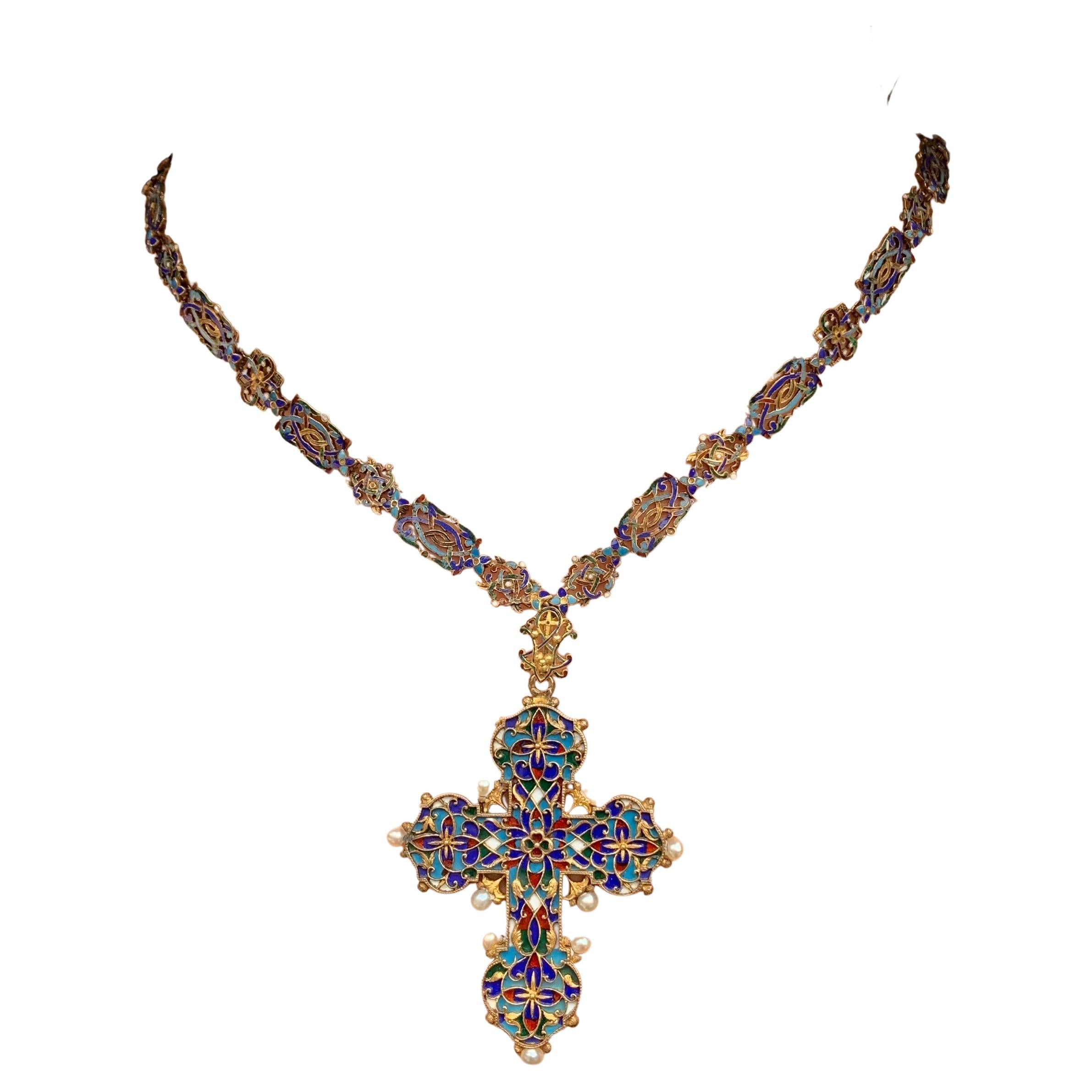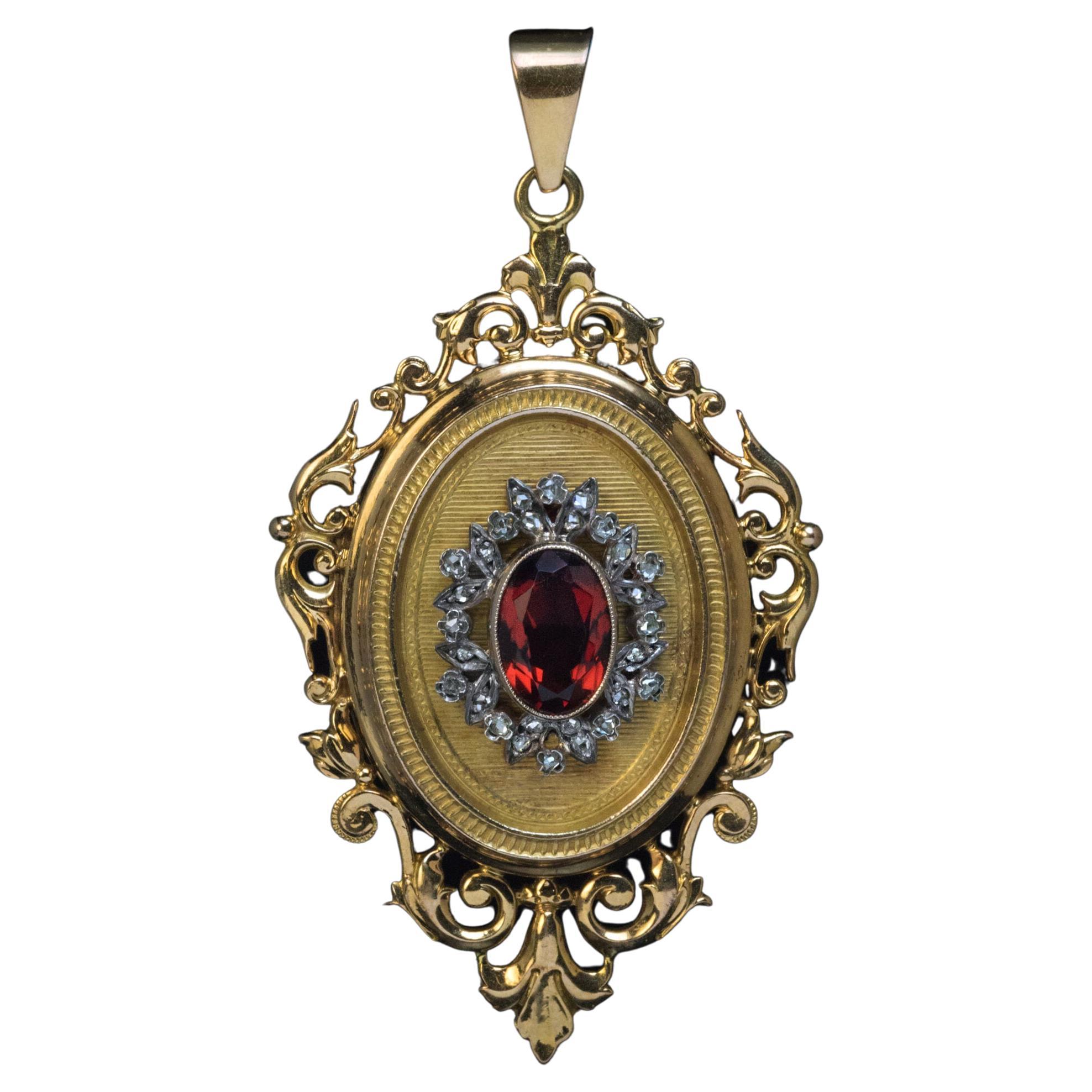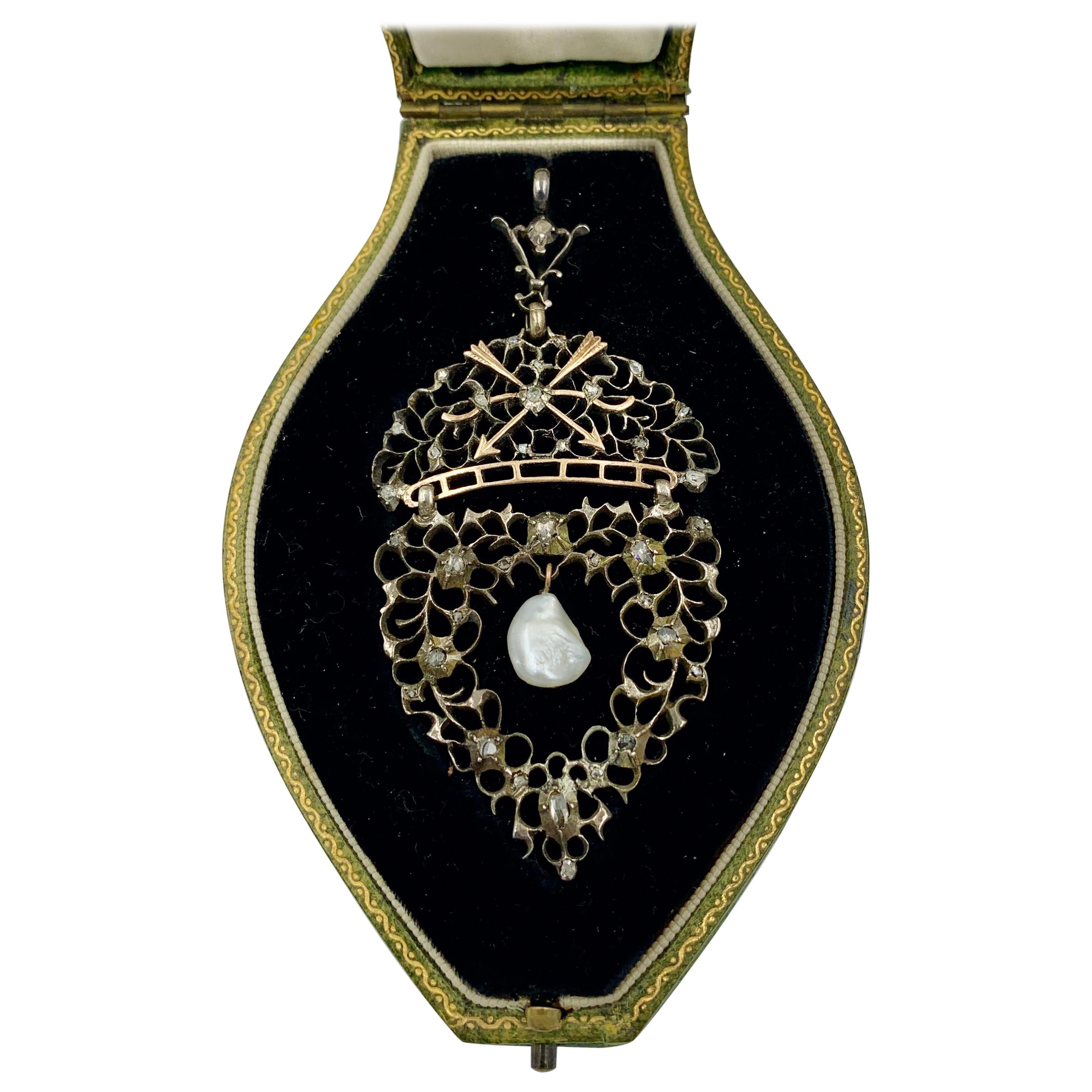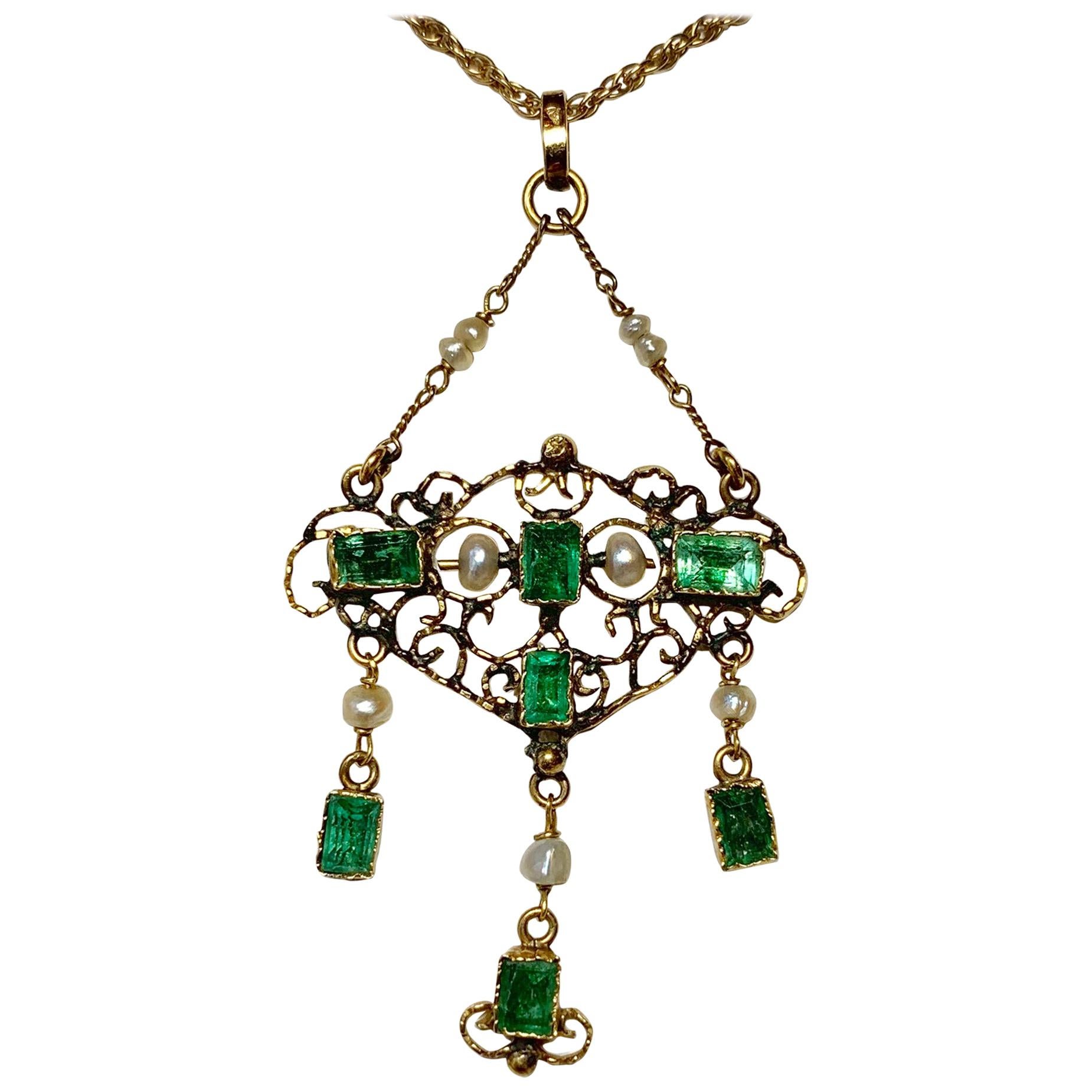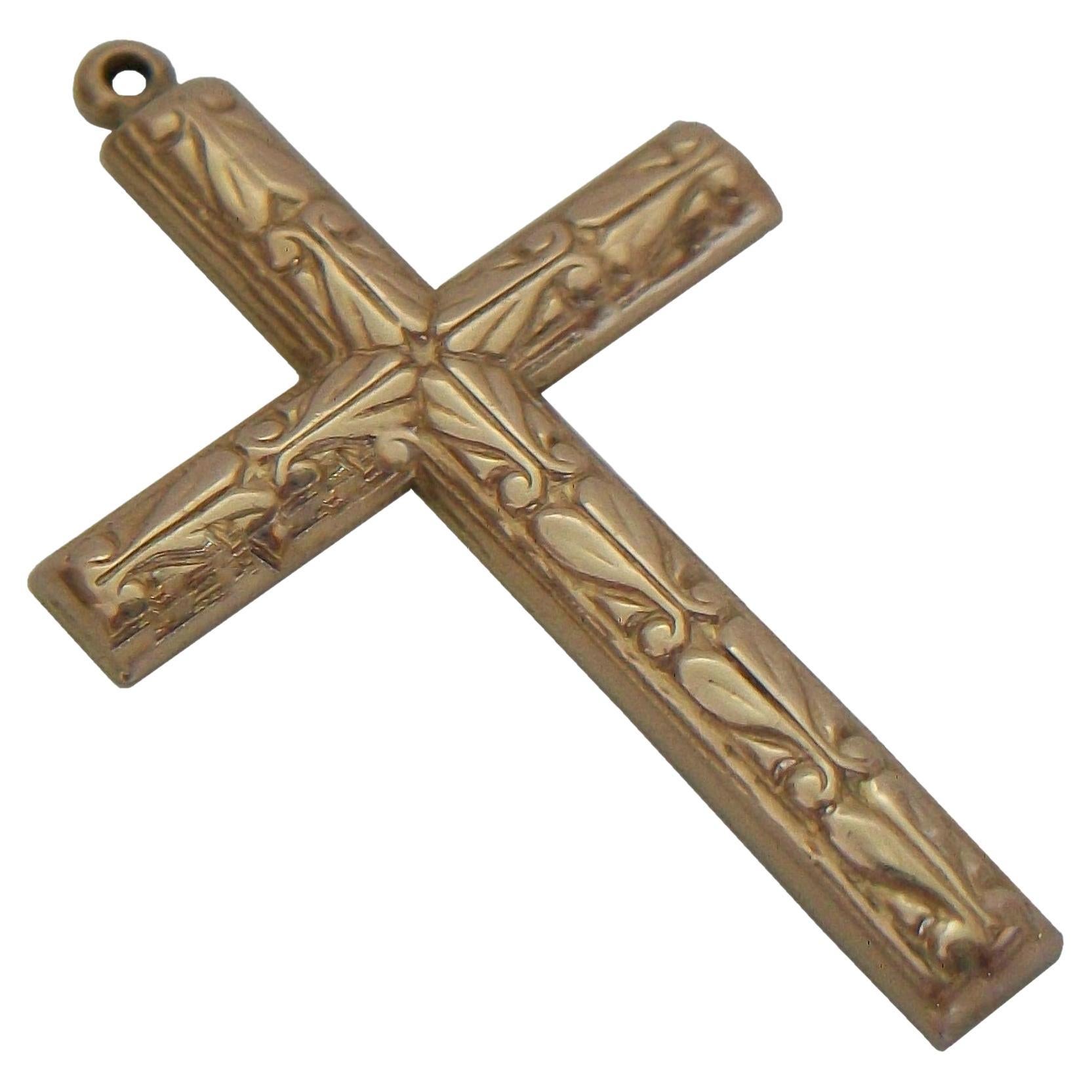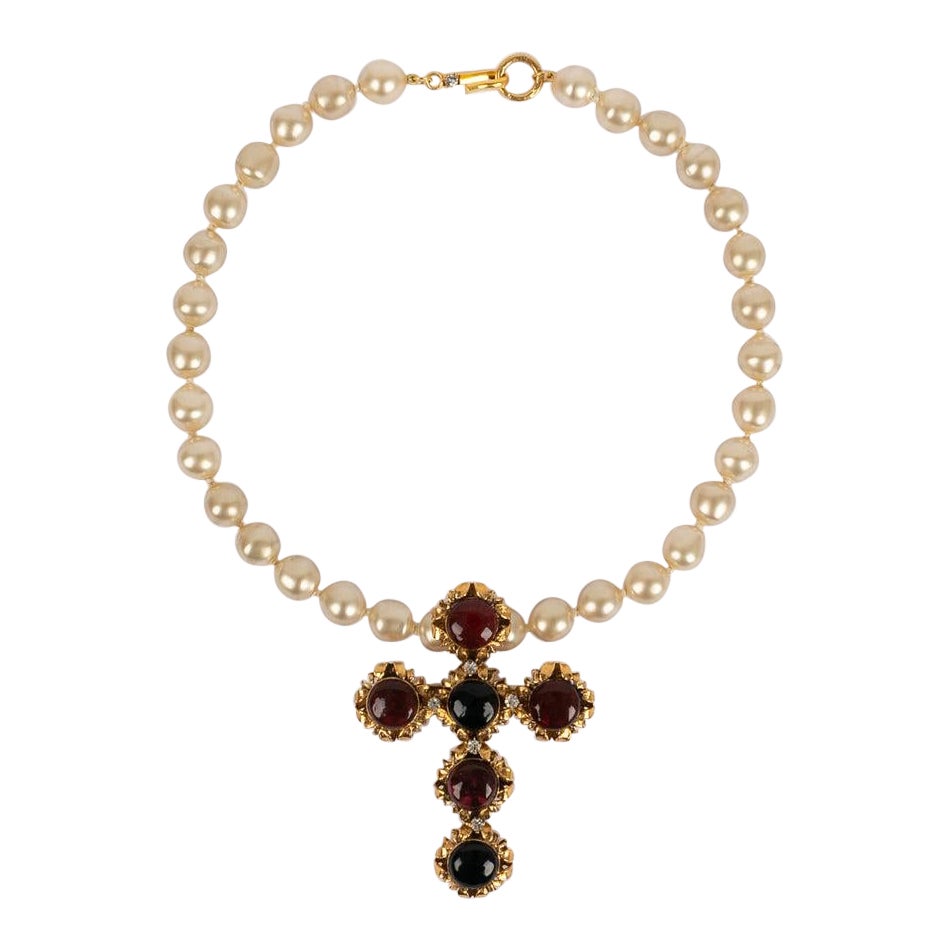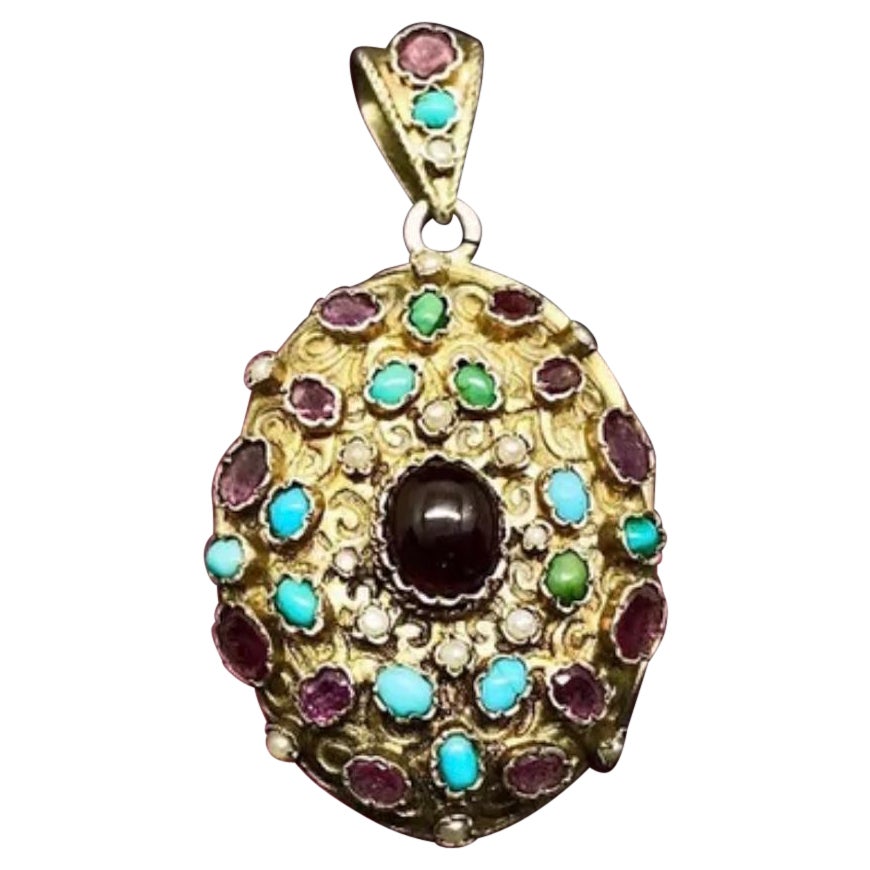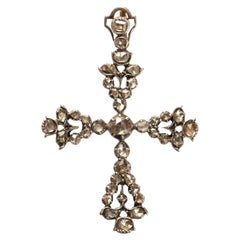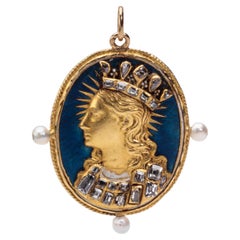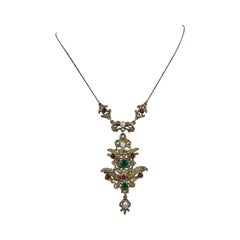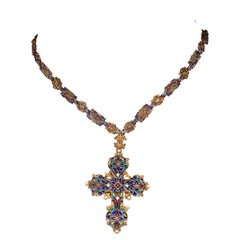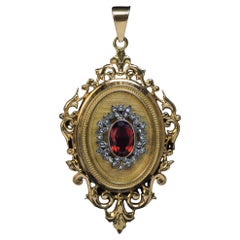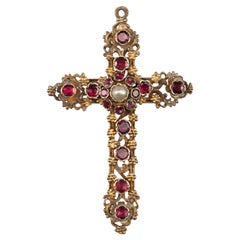
Antique Renaissance Revival Cross Pendant with Pearl
View Similar Items
Video Loading
Want more images or videos?
Request additional images or videos from the seller
1 of 6
Antique Renaissance Revival Cross Pendant with Pearl
About the Item
- Metal:
- Stone:
- Stone Cut:
- Weight:13 g
- Dimensions:Width: 1.75 in (44.3 mm)Length: 2.73 in (69.1 mm)
- Style:
- Period:
- Date of Manufacture:c. 1880
- Condition:Wear consistent with age and use.
- Seller Location:Chicago, IL
- Reference Number:Seller: J-350611stDibs: LU2334213073332
About the Seller
5.0
Vetted Seller
These experienced sellers undergo a comprehensive evaluation by our team of in-house experts.
Established in 1991
1stDibs seller since 2021
5 sales on 1stDibs
Typical response time: 16 hours
More From This SellerView All
- Renaissance Reliquary Pendant with Pearl and EnamelingLocated in Chicago, ILRELIQUARY PENDANT WITH PEARL Spain or Spanish Netherlands, c. 1620 Gold, rock crystal, enamel, pearl, bone relics Weight 12.9 grams; dimensions 40 ...Category
Antique 1620s Spanish Renaissance Pendant Necklaces
MaterialsPearl, Gold, Enamel
- Antique Silver Spanish Cross Pendant with Rock CrystalsLocated in Chicago, ILCross Pendant with Rock Crystals Spain or Portugal, late 17th - early 18th century Silver, gold, rock crystal Weight 9.1 gr.; Dimensions 56.3 × 38.8 mm. An elaborate and elegant cross pendant made of silver with rock crystals in closed settings. The center consists of a larger round gemstone surrounded by five irregular-shaped stones forming the cross. The openwork arms have a triangular shape and are formed of facetted rock-crystals in foliate settings. The obverse side of the cross consists of a layer of gold. An extension with two stones and an angular shaped frame is hooked into the pendant loop, probably to be worn on a velvet band. The pendant is in good, wearable condition. After the Reformation, cross pendants were worn mainly in Catholic countries by men, women, and children. During the seventeenth century, the designs became ever more intricate, and the crosses were often embellished with gemstones, such as rock crystals in this example. These were sourced along the Alpine regions of France, Switzerland, Austria, and Southern Germany. The stones gave the appearance of diamonds. The foliate settings are characteristic of late seventeenth- and eighteenth-century jewelry made in Spain...Category
Antique Late 17th Century Pendant Necklaces
MaterialsCrystal, Rock Crystal, Gold, Gold Plate, Silver
- Antique Gold Pendant with Diamonds and PearlsLocated in Chicago, ILPendant with Virgin Mary as Queen of Heaven Western Europe, Southern Germany (?), Italy (?), c. 1550-1560 Gold, enamel, diamonds, and pearls Weight 13.2 gr; Length 36.9 x 31.2 mm (incl. pearls) This sumptuous image exudes regal power. It portrays the Virgin Mary as Queen of Heaven wearing a dress and crown studded with seven large diamonds and set against a translucent, rich blue celestial background. Far removed from the tender, humble Virgin seen in German and Netherlandish artworks of the period, she is a majestic ruler, mouth sternly set, head tilted upward, and face in full profile. The oval pendant cast in high gold relief with a central medallion, the single figure filling the space, echoes jewelry portraits of the aristocracy during the Renaissance, which similarly offset the ruler’s image against a blue field composed of enamel or lapis lazuli, symbolic of divine power Only the rays of the shining gold halo that emerge behind the Virgin’s head and her long flowing hair (instead of neatly coiffed) distinguish her from female ruler portraits of the period. Three studded pearls, forming an axis, also recall pendants of European rulers. Wealth, royal status, and divine power come together in this opulent pendant. Portraits of the period show similar small oval pendants worn by women in the square of the garment or by men nestled inside multiple chains below the base of the neck. PROVENANCE European Private Collection LITERATURE Compare images from ancient Rome, for example a sardonyx cameo with female head (Kugel 2000, no. 18; Milan, c. 1550), and a pendant with gold, pearls, and enamel in the Staatliche Museum Kassel (Schmidberger/Richter 2001, no. 43; France, c. 1555-1560). For ruler pendants with blue backgrounds see a pendant of King Frances I...Category
Antique 16th Century Pendant Necklaces
MaterialsDiamond, Pearl, Gold
- Antique Eastern European Silver Cross PendantLocated in Chicago, ILRELIQUARY CROSS PENDANT Balkans (probably Bulgaria), 18th-19th century Gilded silver, glass pastes Weight 40.7 grams; dimensions 74 × 15 × 10 mm Double-sided pendant made of gilded silver filigree in the shape of a Greek cross, with pendant loop. The front and side panels composed of intricate filigree scrolls, globules, and a central rosette. Interspersed are crimped collet settings with corded wire base and red, blue, and green glass-paste gem...Category
Antique 18th Century More Jewelry
MaterialsSilver, Gilt Metal
- Late Renaissance Octagonal Gilded Brass Reliquary Pendant with Velvet InteriorLocated in Chicago, ILOCTAGONAL RELIQUARY PENDANT Probably Italy, c. 1600 Fire-gilded brass, glass, velvet, ink on paper Weight 63.2 grams; dimensions 82 × 47 × 21 mm (with loop) Physical description: Double-sided pendant in octagonal form made of fire-gilded brass. Both sides of the pendant with deep profiled frames with glass. The slightly indented side panels comprise openwork friezes with symmetrical scrollwork. On the front is dark red velvet, onto which tiny bone relics of saints (now missing) would have been attached. Labels on a lace-like paper silhouette remain, with names written in ink, mostly faded; only “S. Agnes” is legible. The back is hinged and when opened reveals a velvet-lined interior and paper insert with floral decorations on a turquoise ground, on which fragments of bones are attached. Baluster shaped base for shield-like pendant loop and ring. This reliquary pendant is difficult to situate historically because it is a composite object. It represents traditional handwork in the form of a paper cutout, combined with a jeweler’s beautiful fire-gilt brass case. The work of paper cutting, painting, and ornamentation, sometime combined with needlework, is comparable to work still being done in the nineteenth century by nuns and pious ladies. It is prayerful work, a devotional exercise in itself, and shows reverence to the tiny relic fragments that it would have framed and honored. Early versions of this sort of handiwork might be found in the meticulous displays sometimes called “Paradise Gardens.” These were made, beginning in the sixteenth century, by the nuns at Mechelen, in northern Belgium, in multimedia handwork displays of sewing and gluing, combining relics with paper, cloth, glass, metal wire, and found materials. These textured and pious displays were then combined with paintings and cases by professional artists and artisans, as in the example in Cassel. Unfortunately, because of water damage, only one of the labels of the original relic displayed in this reliquary is legible, inscribed “S. Agnes” at the center top; the other names are faded. Presumably the deep velvet-lined box would have also held an assortment of relics other than the ones that were visible through the glass, and perhaps there would have been another display in the glass on the other side of the pendant. There is a second paper insert, this one decorated with a turquoise ground and silhouette flowers to which bone fragments seem to be still attached. The octagonal case, in contrast to the paper cutout, is not at all “home-made.” It has an openwork frieze in scrollwork patterns familiar from enamel work and other metalwork done for European courts and nobility. It is not unlike cases for expensive watches...Category
Antique Early 1600s Italian Pendant Necklaces
MaterialsBrass
- Antique Spanish Jet Amulet Pendant with FigaLocated in Chicago, ILAMULET PENDANT WITH FIGA Spain, c. 1620–1630 Jet, silver, and enamel Weight 60.7 grams; dimensions 85 × 49 × 18 mm Large pendant in the shape of a hand carved from jet with a clinched fist in the figa (Spanish higa) gesture. In the palm of the hand is a heart carved in relief and on the back a six-ray star in a circle. The silver mount covers the wrist like a cuff and is decorated with a frilled border, and on the front with collet-set bosses with silver C-scrolls against blue enamel; on the back is a roundel in relief with floral motif. Domed base for the pendant loop in pea-pod form. The figa (also fica or higa) represents an age-old symbol of protection against the evil eye and other demonic threats. Its origins were pagan and buried deep in antiquity. Roman examples, such as one found recently in an archeological excavation in London, also make it clear that the protective qualities are based in a sexual symbolism–particularly the power of the phallus. The Roman bone figa/phallus in effect represents the phallus twice; that is, the gesture made by the figa hand is generally explained as fingers representing the female genitalia (vulva) penetrated by the phallus of the thumb. But other interpretations are less specific, including explanations that the left hand is the feminine principle, and the right hand is the masculine. In Spain, jet figa are common; we see one in the portrait of Anne of Austria the infanta (p. 75). That is not to say that the objects are not sumptuous or treasured. Jet was a very valuable material, and in many examples like this one, the figa is embellished with beautiful enameling or is even gem-studded. Comparable objects occur in equally sumptuous materials such as rock crystal. The enameled setting allows a dating of these objects that otherwise might prove difficult, given that the production of such objects in Spain is so consistent over centuries. Indeed, there is another, even more elaborately carved example in this collection, attached to the “magic belt” (no. 9). That example may belong to an earlier group. That figa includes deeply excavated carving, including on the upper surface, an M-shaped design that Walter Leo Hildburgh links to the heart shape (as it occurs more explicitly on this example). Hildburgh argues that its presence is especially common on these objects and that it originally represented the Sacred Heart of Mary...Category
Antique Early 17th Century Spanish Pendant Necklaces
MaterialsSilver
You May Also Like
- Antique Emerald Ruby Pearl Pendant Necklace Austro-Hungarian Renaissance RevivalLocated in New York, NYThis is a magnificent piece of Austro-Hungarian Emerald Ruby and Pearl jewelry. It is in the Renaissance Revival style and dates to circa 1870. The...Category
Antique 19th Century Austrian Renaissance Revival Pendant Necklaces
MaterialsEmerald, Pearl, Ruby, Silver, Gilt Metal
- Antique Renaissance Revival Polychrome Enamel, Pearl 14K Gold Cross NecklaceLocated in New York, NYExquisite museum quality antique reticulated polychrome enamel, natural pearl 14K gold Renaissance Revival cross necklace. 19th Century A ra...Category
Antique 19th Century European Renaissance Pendant Necklaces
MaterialsPearl, 14k Gold, Enamel
- Renaissance Revival Antique French Locket PendantLocated in Chicago, ILFrance, circa 1880s This ornate 18K gold locket pendant is designed in the Renaissance Revival style. The front is centered with a reddish orange ci...Category
Antique 1880s French Renaissance Revival Pendant Necklaces
MaterialsCitrine, Diamond, Gold, 18k Gold, Silver
- Antique Child & Child Renaissance Revival Rose Cut Diamond Baroque Pearl PendantBy Child & ChildLocated in New York, NYThis is a spectacular Museum Quality Antique Pendant in the Renaissance Revival style set with Rose Cut Diamonds and a central hanging Baroque Pearl made by the acclaimed British jewelers, Child & Child (1880-1916), of London. The pendant remains in its original fitted velvet, silk and leather box with the Child & Child insignia. The pendant is made of Silver topped with Pink Gold as was the custom of the Renaissance jewelry...Category
Early 20th Century British Renaissance Revival Pendant Necklaces
MaterialsPearl, Diamond, Gold, Silver
$4,500 Sale Price22% OffFree Shipping - Renaissance Revival Emerald, Ruby and Pearl PendantLocated in London, GBA Renaissance revival emerald, ruby, pearl and enamelled gold pendant, the rectangular-cut emerald estimated to weigh 1.5 carats rub-over set to the centre, flanked with one diamond-...Category
Antique 1880s British Renaissance Revival Pendant Necklaces
MaterialsEmerald, Pearl, Ruby, Diamond, Natural Pearl, 18k Gold, Gold, Yellow Gol...
- Antique Emerald Pearl Pendant Necklace 14 Karat Gold Renaissance RevivalLocated in New York, NYThis is an antique Emerald and Pearl Pendant Necklace set with seven gorgeous green emerald cut rectangular Emeralds in the Renaissance Revival Style. The Emeralds total approximate...Category
20th Century Unknown Renaissance Revival Pendant Necklaces
MaterialsEmerald, Pearl, 14k Gold, Yellow Gold, Gold
$1,600 Sale Price20% OffFree Shipping
Recently Viewed
View AllMore Ways To Browse
Renaissance Revival Cross
Paste Cluster
Medieval Gold Crosses
Blood Of Christ
13 Mm Pearl Studs
Paste Crosses
Paste Cross
Pearl Blood
Antique Garnet Cross
Garnet Cluster Pendant
Hungarian Gold Pendant
Garnet Paste
Blood Garnet
1895 Ruby
Cross Pendant Paste Jewellery
Antique Ruby Cross Pendant
German Cross Pendant
Garnet And Pearl Cross

